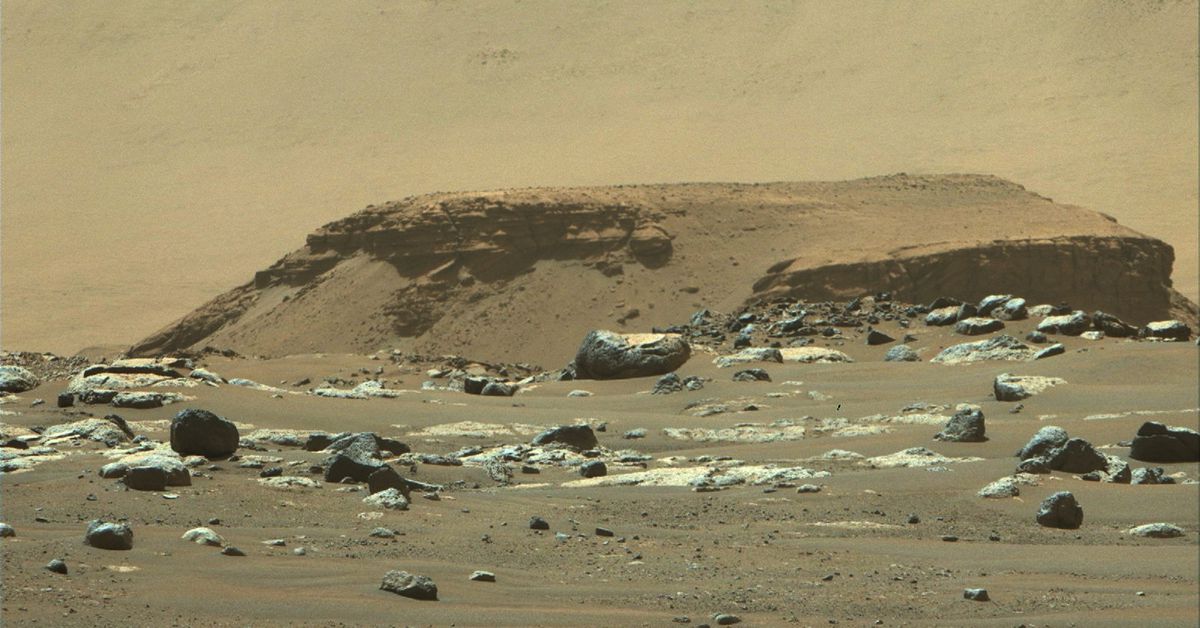Mars might be hiding most of its old water underground, scientists say
Source: The Verge added 16th Mar 2021Vast amounts of ancient Martian water may have been buried beneath its surface instead of escaping into space, scientists report in the journal Science. The findings, published Tuesday, may help untangle a clash of theories seeking to explain the disappearance of Mars’ water, a resource that was abundant on the planet’s surface billions of years ago.
Through modeling and data from Mars probes, rovers, and meteorites, researchers at the California Institute of Technology found that a broad range — between 30 to 99 percent — of the Red Planet’s earliest amounts of water could have vanished from the surface through a geological process called crustal hydration, where water was locked away in the rocks of Mars.
Evidence of past water on Mars is written all over its rocky surface, where dried-out lake beds and rock formations illustrate a world shaped by liquids from more than 3 billion years ago. For years, scientists thought this water had mostly escaped outward into space, leaving the planet in its present — very dry — condition.
But that takes time. And the rate at which the water could have escaped the atmosphere, paired with the predicted amount of water that once existed on the Martian surface didn’t quite line up with modern observations of the planet. “If that persisted through the past 4 billion years, it can only account for a small fraction of water loss,” says Renyu Hu, one of the study’s co-authors. That left researchers with a key question: where exactly did the rest of the water on Mars go?
The study, led by Eva Scheller, a graduate student in geology at Caltech studying planetary surface processes, might offer an answer. The study finds that most of the water loss occurred during Mars’ Noachian period between 3.7 billion to 4.1 billion years ago. During that time, the water on Mars could have interacted and fused with minerals in the planet’s crust — in addition to escaping the planet’s atmosphere — locking away as much water as roughly half of the Atlantic Ocean.
“One of the things our team realized early in the study is that we needed to pay attention to the evidence from the last 10 to 15 years of Mars exploration in terms of what was going on with our discoveries about the Martian crust, and in particular the nature of water in the Martian crust,” says Bethany Ehlmann, a co-author on the study and professor of geological and planetary sciences at Caltech.
Water can break down rocks through a process called chemical weathering, which sometimes results in minerals becoming hydrated. Hydrated minerals take up and store water, locking it away. For example, gypsum, a water-soluble mineral found naturally on Mars, can keep its water trapped unless heated at temperatures higher than 212 degrees Fahrenheit.
For years, scientists have observed the distribution of water-bearing minerals across the Martian surface, thanks to spacecraft like NASA’s Mars Reconnaissance Orbiter, which has been mapping the planet’s geology and climate since 2006. But those views alone are sometimes limited. “You have to wave your hands and extrapolate about how thick that layer is that you see at the surface,” says Michael Meyer, the lead scientist for NASA’s Mars Exploration Program.
“It’s only by having measurements in particular places on the surface with your rovers or landers, like Phoenix, or your occasional view of a fresh crater, that you get an idea of how thick the particular spot is on the planet for the hydrated minerals that you’re looking at,” he says. “So the answers are there, but they slowly build through time as you gain more data.”
That’s what led to the study’s findings that oceans’ worth of ancient water may have escaped inward, not outward. “We wanted to understand this at different scales,” says Scheller.
Crustal hydration happens on Earth, but our active plate tectonic system recycles rock deep inside our planet, heating rocks and releasing water in the process. That water gets sent back to the surface through volcanic activity, says Christopher Adcock, a planetary geochemist at the University of Nevada Las Vegas.
Mars, on the other hand, is not as geologically active as Earth, which could explain why it only has limited water on its surface. The clearest evidence of water on Mars comes in the form of ice at the planet’s poles and in tiny quantities in the atmosphere. Scientists have studied hydrated rocks on the Moon, Mars, and on other planetary bodies as a potential source of drinkable water for future astronaut missions or fuel that could power habitats and rockets.
Adcock, whose studies include how humans can synthesize and use minerals on Mars for drinking water and rocket fuel, says the findings from Scheller’s team don’t totally change the game for resource utilization, “but it is certainly an encouraging reminder that the water we need for long term human missions to Mars might be right at our feet when we get there.”
Last month, NASA landed its Perseverance rover on Mars’ Jezero Crater, the site of a dried-out lake bed whose soil might hold the most pristine evidence of hydrated minerals — and fossilized microbial life. Perseverance will scoop up tiny soil samples and scatter them across the crater’s surface for a future “fetch” rover to retrieve. That presents a tantalizing opportunity for the researchers behind the Science study.
“Samples from Jezero will help us test this model,” Ehlmann says. “It amplifies the importance of bringing those samples back.”
brands: Alone Atlantic EVA fresh It JPL Key One other Phoenix Planet ROCK Space Team the game Vegas Wanted WAS Wave media: 'The Verge' keywords: NASA
Related posts
Notice: Undefined variable: all_related in /var/www/vhosts/rondea.com/httpdocs/wp-content/themes/rondea-2-0/single-article.php on line 88
Notice: Undefined variable: all_related in /var/www/vhosts/rondea.com/httpdocs/wp-content/themes/rondea-2-0/single-article.php on line 88
Related Products
Notice: Undefined variable: all_related in /var/www/vhosts/rondea.com/httpdocs/wp-content/themes/rondea-2-0/single-article.php on line 91
Warning: Invalid argument supplied for foreach() in /var/www/vhosts/rondea.com/httpdocs/wp-content/themes/rondea-2-0/single-article.php on line 91
